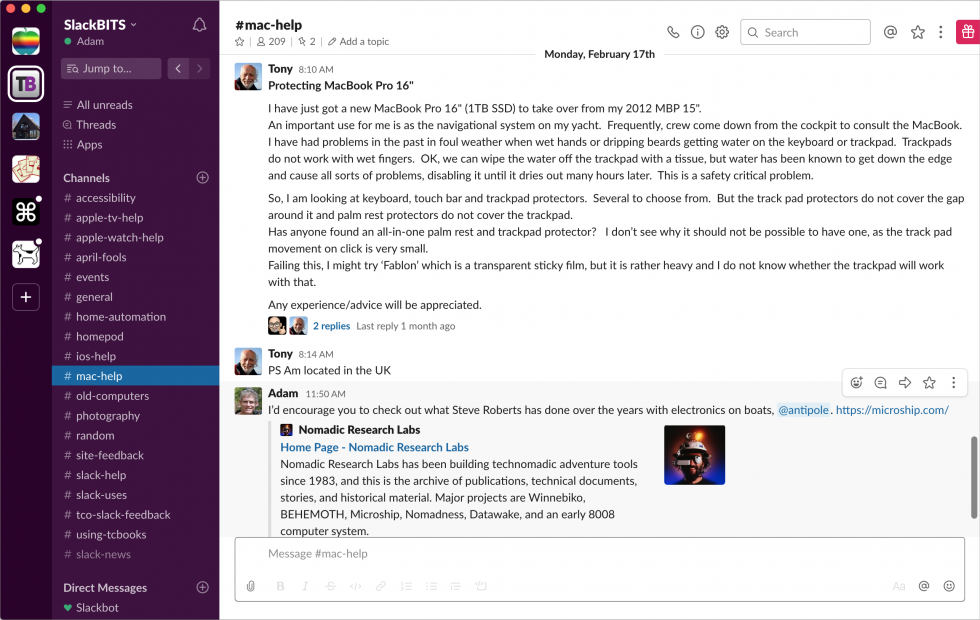Whether you’re working from home or just stuck at home, it can be tough to communicate with colleagues, friends or family. Sure, there’s email, but that gets hard to manage quickly, and it can be difficult to stay focused with so much news rolling in. For friends and family, Facebook might seem to be the digital town square. However, Facebook isn’t ideal for business communication.
For an alternative that doesn’t involve relying on overloaded email inboxes or handing everything about your online life over to a corporate Big Brother, consider the group messaging tool Slack, which has become popular with small and large firms, non-profits, academic departments, student project teams and government agencies. Although it’s aimed at organizations that pay a monthly fee for every active user, Slack offers a free tier with all the features you would need to create your own online community for your workgroup, family or friends. Everyone can join in since Slack has apps for macOS, iOS, Windows and Android, and it can be used in any desktop Web browser.
Conceptually, Slack is similar to Apple’s Messages, in that you can communicate by typing short messages and sharing graphics and other files. You can even have one-on-one voice calls (group calls, screen sharing and videoconferencing are limited to the paid plans).
What sets Slack apart from Messages, WhatsApp, Google Hangouts and similar tools is that it lets you segment discussions into “channels,” which can either be public, so that everyone in the group can see them, or private, so only invitees can participate. Plus, you can have “direct message” conversations with one or more individuals.

The beauty of Slack channels is that they’re easy to create, and they bring together all communications relevant to a particular group, project, client or topic. Channels help focus discussions, so those who are interested in only certain channels aren’t overwhelmed by irrelevant chatter.
For an extended family, you might create channels by branch (so your brother can ignore your in-laws’ conversations), parts of the country (so relatives who live elsewhere don’t have to see the local family members’ dinner plans) and events (like your Cinco De Mayo celebration or a family reunion). Or, in a design team’s Slack group, you might want channels for each major client or project, along with channels for financial or human resources topics. There’s no one right set up—the goal is to keep discussions relevant and focused.
How do you keep up with discussions? Slack has flexible notifications. It lets you choose to be notified about everything, or to select just direct messages, mentions and keywords. Alternatively, you can choose to receive no notifications and check in manually. You can also choose to be notified of replies to threads you’re in. You can override those defaults for any channel or conversation, which ensures you’re notified only by people or topics that interest you. Plus, if you leave your Mac, Slack can repoint notifications to your iPhone automatically, with separate settings to make sure you control how those notifications work.

Slack provides tons of other features that are useful in any group. You can share and comment on files of any type, which is far more effective than sending attachments around in email. You can create “posts” and get others to edit them collaboratively—a boon when trying to craft the perfect bit of text for some purpose. And you can integrate hundreds of Internet services into Slack so it can act as a single dashboard for many other apps, including Zoom, for example.
Getting started with Slack is fairly easy.
-
Create a Slack workspace. Slack provides instructions for basic setup.
-
Set up channels. Create a few channels to help people feel like they’re in the right place. You can always make more channels later.
-
Invite people in. You can invite users to your Slack during setup, but it’s better to wait until you’ve set up your channels. Make sure to use everyone’s preferred email address when inviting them.
-
Help people to install Slack apps. For those who are tech-savvy, installing Slack’s client apps isn’t hard, but you might need to provide support for those who are less experienced. arobasegroup is happy to help.
-
Provide name advice. Slack lets each user set a full name and a display name, and you might want to recommend a particular format (first name only, or first name and last initial) that makes display names unique and easily understood and typed.
-
Help people configure notifications. Perhaps the hardest part of using Slack is getting notifications adjusted right for each person. Slack offers guides for desktop, email and mobile notifications, along with additional help.
About arobasegroup
arobasegroup has been consulting with clients and advising the best use of Apple Technology since 1998. We listen to our customers and solve problems by addressing their specific, unique needs; we never rely on a one-size-fits-all solution or require them to use a specific product. arobasegroup is your advocate in all things related to information technology. Contact us to learn how we can help: info@arobasegroup.com.





